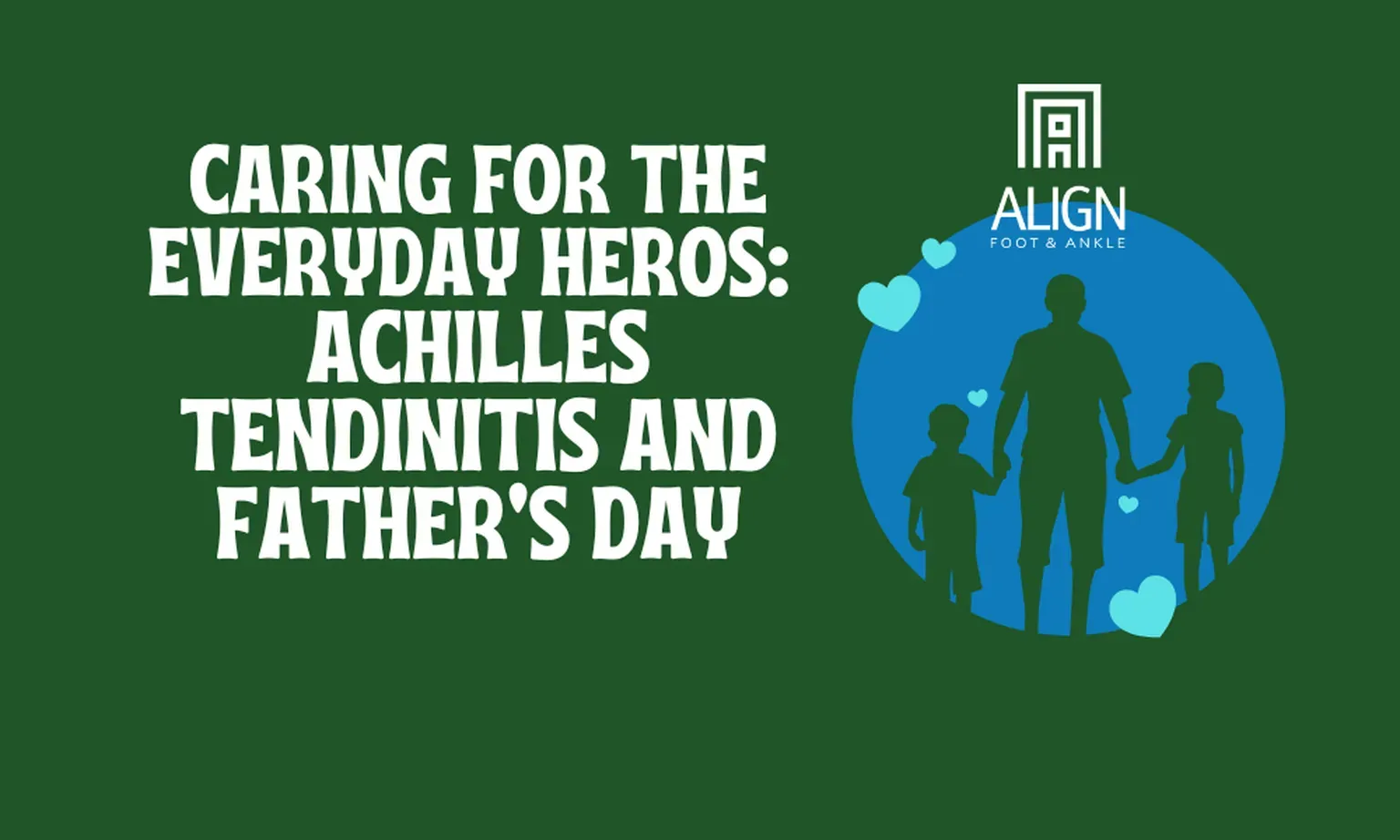CARING FOR THE EVERYDAY HEROES: TENDINITIS AND FATHER’S DAY
IN THIS WEEK’S BLOG, WE DECIDED TO FOCUS ON A COMMON ISSUE THAT, ALTHOUGH CAN OCCUR IN BOTH MEN AND WOMEN, IS MOST COMMON IN MEN (MAYO CLINIC). IN THIS BLOG, WE WILL DELVE INTO THE TOPIC OF ACHILLES TENDINITIS.
Father’s Day is a time to celebrate and appreciate the important role that fathers and father-figures play in our lives. It’s a day when we honor their love, sacrifices, and unwavering support. In this week’s blog, we decided to focus on a common issue that, although can occur in both men and women, is most common in men (Mayo Clinic).
Achilles tendinitis, a condition characterized by inflammation of the achilles tendon, is more often seen in men. In this blog post, we will explore the causes, symptoms, and treatment of achilles tendinitis.
Causes
The achilles tendon, which is located at the back of the ankle, plays a crucial role in walking, running, and jumping. However, when the achilles tendon becomes inflamed or irritated, it can lead to achilles tendinitis. Some common causes of achilles tendinitis include:
- Overuse: Achilles tendon is a strong fibrous band that connects the calf muscles to the heel bone. However, when the achilles tendon is subjected to increase physical activity, improper footwear, and tight calf muscles, the tendon can develop small tears. Therefore, repetitive stress or overuse can negatively affect your Achilles tendon.
- Age-related degeneration: As we age, tendons become less flexible and more prone to injury. In particular, achilles tendinitis becomes more of a risk as you get older.
- Medical conditions and diseases: Certain medical conditions, such as rheumatoid arthritis, diabetes, and gout, can contribute to the development of tendinitis.
Understanding the Importance of Self-Care
As we celebrate Father’s Day, it’s crucial to emphasize the importance of self-care. Some fathers often prioritize the well-being of their families over their own, but neglecting personal health can lead to long-term consequences. Achilles tendinitis most noticeable symptom is pain and stiffness along the back of the leg, near the heel. This pain may worsen with activity, such as running or jumping, and often eases with rest. Other symptoms of Achilles tendinitis include swelling, tenderness, and a limited range of motion in the ankle joint.
Treatment
There are a range of treatment options for Achilles tendinitis in your foot or ankles. Some treatment options are:
- Rest: Resting the affected area is crucial to allow the tendon to heal. Avoid activities that aggravate the pain and give your body time to recover.
- Ice and heat therapy: Applying ice packs to the affected area for 15-20 minutes several times a day can help reduce inflammation. Once the initial swelling subsides, alternating with heat therapy can promote blood circulation and alleviate stiffness.
- Pain management: Over-the-counter nonsteroidal anti-inflammatory drugs (NSAIDs) like ibuprofen or naproxen can help relieve pain and reduce inflammation. However, consult with Dr. Ho-Ellsworth before taking any medication.
- Physical therapy: At Align Foot & Ankle Clinic, we can provide home physical therapy exercises or refer you to a physical therapist who can guide you through exercises and stretches to strengthen the affected tendon and improve flexibility.
- Immobilization: In severe cases, immobilizing the affected area with a brace or cam boot may be necessary to allow the tendon to rest and heal.
- Laser therapy: At Align Foot & Ankle Clinic, we offer Class IV laser therapy, a safe, painless option to relieve pain by reducing inflammation and promoting tissue healing.
- Cryopreserved Biologics such as umbilical cord-derived Wharton’s jelly injection or amniotic-derived tissue is the most recent and advanced non-surgical option we offer at Align Foot & Ankle. These allografts containing growth factors and hyaluronic acid, when injected, offers healing and regenerative properties and aims to provide significant support to the achilles tendon by reducing inflammation and promoting healing at the site (Werber, Brandeisky & Phelan).
This Father’s Day, let’s not only celebrate and honor fathers but also raise awareness about achilles tendinitis. If you are experiencing pain or swelling at the back of you ankle, don’t wait! Call us at (512) 882-4911 or schedule an appointment on our website.
References
Werber, Bruce. “Amniotic Tissues for the Treatment of Chronic Plantar Fasciosis and Achilles Tendinosis.” Journal of Sports Medicine, 27 Sept. 2015, www.hindawi.com/journals/jsm/2015/219896/.
Brandeisky, John, and Dorothy Kurtz Phelan. “Clinical Outcome of Achilles Tendon Repair Using Viable Intact Cryopreserved Umbilical Tissue Versus Standard of Case.”, www.hmpgloballearningnetwork.com/site/wounds/rapid-communication/clinical-outcome-achilles-tendon-repair-using-viable-intact.
Heather Schaefbauer, D.P.M. “Achilles Tendinitis Causes and Care.” Mayo Clinic Health System, 28 Apr. 2023, www.mayoclinichealthsystem.org/hometown-health/speaking-of-health/how-one-tendon-can-throw-off-stride#:~:text=Achilles%20tendinitis%20is%20most%20common%20in%20men.&text=You’re%20at%20a%20higher%20risk%20as%20you%20get%20older.



